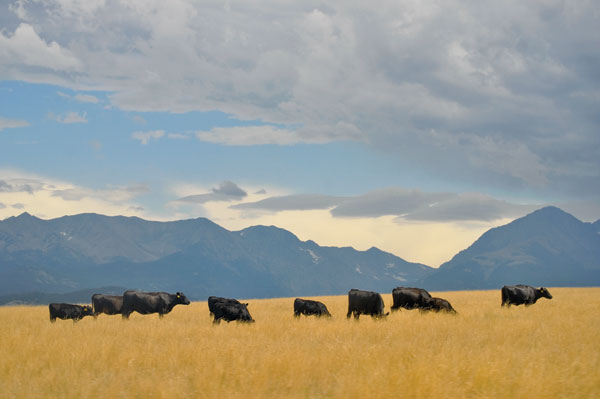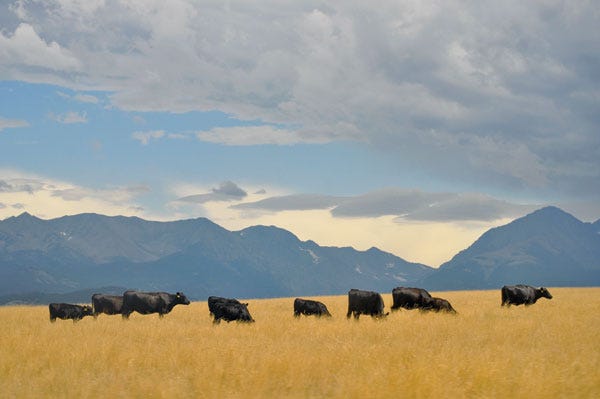Fewer Cattle This Year, But Pasture Value Is Up
Fewer cattle are competing for grass, but U.S. pastureland values grew on average by 2% over the previous year. View charts and figures for this story here.
September 30, 2011

Continued low interest rates, robust price increases for row-crop land and strong cattle prices are nudging up pasture values.
The average value of pastureland rose nearly 2% through the start of this year to $1,100/acre, according to USDA. That’s double last year’s pace of 1%, and $10/acre above the 2008 nominal market peak. Interestingly, pasture values advanced despite fewer cattle competing for grass: The number of beef cows is down another 1% this year, and ranchers are also holding 5% fewer beef replacement heifers.
Photo by Lauren Chase, Montana Stockgrowers Association
Regionally, pasture prices increased 6-7% across the Corn Belt and Northern and Southern Plains. Pasture prices in the Southeast continue to contract, deflating 8.4% for the 12 months through Jan. 1, and 27% under the region’s 2008 market peak.
Corn Belt tops the list
Pasture price increases are strongest in the Corn Belt, where high grain prices have lifted the value of all tillable land. In Iowa, the country’s top corn-producing state, pasture values spiked 26%, to an average $2,650/acre. This gain exceeds the 24% rise in Iowa cropland values and suggests buyers may be bidding up pasture tracts for conversion to row-crops. Some pasture conversions occurred when land prices jumped in 2007-2008, says Iowa State University economist Mike Duffy. But, so far, Duffy isn’t aware of another pick-up in conversions.
Surveys of market conditions indicate pasture values continue to edge up in the second quarter, though at a slower pace than in the first quarter. In the West Central Plains and Mountain States, pasture values rose an average of 1% in the second quarter across Kansas, western Missouri, Nebraska, Oklahoma, Wyoming, Colorado and northern New Mexico.
For the 12 months through June, buyer demand appears strongest in Nebraska, where pasture tracts are trading nearly 17% above year-ago levels, compared to an average 11% across the region, according to the Federal Reserve.
The severe drought in the Southern Plains is putting pressure on the ranchland market – especially in Texas where poor pasture conditions have hastened herd liquidations. Texas ranchland prices eased 2.3% in the second quarter to an average of $1,716/acre, according to the Federal Reserve. Texas ranchland values are off about 1% from a year ago, bankers say.
Market participants report very little demand for both recreational and cattle ranch properties. “Things are really slow unless you have a sizeable place that appeals to high net-worth individuals who are parking money,” reports Chad Dugger, with Charles S. Middleton and Son, a ranch brokerage and appraisal firm in Lubbock, TX.
Ranchers began thinning cattle herds at the end of last year, with many herds culled to bare minimums to preserve rangeland and manage dwindling stock water supplies, says John Taylor, national farm and ranch manager for US Trust/Bank of America in Dallas.
With rangeland exhausted, ranchers are trucking in alfalfa hay from irrigated growers in New Mexico and up into Colorado, Nebraska and Kansas. Hay prices have tripled from a year ago to $300/ton.
Scrambling to survive
In parched West Texas, some large, old-line ranching families have mobilized to preserve the core of their genetic seedstock by moving their best young cows as far as 1,000 miles north to Montana, Colorado, Nebraska, South Dakota and Wyoming. Spade Ranches of Lubbock normally keeps cows in production for 10 years. This year, it sold most of its eight- and nine-year-old cows to ranchers in Arizona, California and Mississippi, cutting its herd of 6,400 mama cows to 4,000.
The ranch also usually retains its bred-heifer crop, but sold them to producers in Colorado and Wyoming. Spade is now moving 1,000 young, most-productive cows to the North.
“Our thinking is to get off of these ranches and let the country recover,” says CEO John Welch. Welch and the majority of other area ranchers moving animals out of state plan to bring their stock back to Texas in a year. But, some are striking long-term leases, using the opportunity to expand north and perhaps restock their Texas herds by bringing heifer calves back or through cattle purchases.
Under less severe past droughts, ranchers would cull their herds and secure lease pasture within 200 miles. But this year’s drought is so widespread that good grass isn’t available south of northern Kansas to northern Colorado. All told, some 5,000-7,000 cows in the Lubbock region are being moved north.
The relocation of Southern Plains cattle north due to drought and the ongoing conversion of pasture to row-crop land in the eastern Plains has firmed up pasture lease rates in the Northern Plains. Where some Nebraska pastures went unleased last year due to a surplus of lush pasture, all leases are taken up this year, reports Cort Dewing, director of field operations with the Nebraska Board of Educational Lands and Funds, which manages 951,686 acres of pasture leases.
“We’re in a healthy environment for pasture and the value of it should be good because the cost of gain in the feedlot is high,” Dewing says. Lease rates in north central Nebraska – Brown, Rock, Keya Paha and Cherry counties – are running at $35-$40/cow-calf pair/month.
Across the Sandhills, rates range from a high of $41/animal unit month (AUM) in the eastern Sandhills to a low of $16/AUM in the west, says Ron Vance, field supervisor with the state land board. The agency plans to raise 2012 lease rates from 7.5% in the eastern Sandhills to 2.5% in the west.
In neighboring Kansas, quality bluestem pasture is selling at $1,200-$1,400/acre, says Richard Griffin, with Griffin Real Estate and Auction Service in Cottonwood Falls. Prices rose last spring from a $1,000-$1,200/acre band where they had traded since 2009.
The drought has given cattlemen a sense of urgency to add to their land bases beyond the moisture-stressed Southern Plains, Griffin says. In June, a Texas rancher paid $1,400/acre for 1,991 acres of bluestem pasture on the eastern edge of Marion County. Meanwhile, net lease rates to landowners in the Flint Hills region are running $24-$26/acre for the April 15- Oct. 15 grazing season. That’s up $2-$3/acre from a year ago, Griffin says.
Mike Fritz is editor and publisher of Farmland Investor Letter. Reach him at [email protected] or visit www.farmlandinvestorcenter.com.
You May Also Like


.png?width=300&auto=webp&quality=80&disable=upscale)
